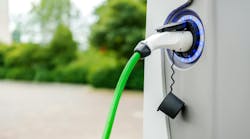Better planning would have had me writing about Earth Day a couple of months ago, so it would have been in the April issue. Coverage was limited in February, but now it’s April. Earth Day is the major story, and the material is fascinating from a trending technology viewpoint. One trending topic struck a chord with me — the need for a network of EV (electric vehicle) fast-charging stations.
It’s one of reasons there is so much buyer’s resistance when it comes to purchasing an EV. Finding a charging station can be a major issue. It’s not easy to install one for a homeowner and a real problem for renters. The stories about going cross-country can be shocking without some extremely careful planning, but there’s hope. The hope comes in the form of news releases from Walmart and other retailers.
Retail Segment Getting Busy
Walmart’s Vishal Kapadia, senior VP of Energy Transformation, made an announcement recently. Kapadia said Walmart was planning to add thousands of fast-charging stations to its existing network of over 1,300 fast-charging stations. I had been following all the news about the company’s environmental awareness with the installation of rooftop solar, but somehow I had missed the fact they had a network of fast EV charging stations.
The release went on to say that Walmart and Sam’s Club have an existing network of fast-charging stations located at 280 of their locations across the country. The company has decided to add thousands more charging stations to that network through 2030. With more than 5,000 stores and clubs located within 10 miles of approximately 90% of all Americans, this is going to be a gamechanger when it comes to making fast-charging stations available to the general public.
Along with Walmart, there have been a flood of announcements from companies like TravelCenters of America saying they are installing about 1,000 charging stations in their facilities. 7-Eleven reported plans to establish one of the largest fast-charging networks in North America. GM, EVgo, and the Pilot Company (Pilot and Flying J travel centers) are partnering to build a national fast charging network. Plans call for 2,000 charging stations in their facilities.
Planning & Standards
A blog from EEI’s (Edison Electric Institute) National Electric Highway Coalition (NEHC) told about a recent publication from the Great Plains Institute. The report was titled “United States EV Fast-Charging Corridor Road Map.” This road map presented an interesting picture of building a full coverage national network of fast-charging stations. Editor’s note – the NEHC membership consists of more than 60 investor-owned, municipal electric companies, and electric cooperatives, which continues to grow.
The NEHC blog said their membership’s companies “have invested more than US$4 billion in customer programs and projects to deploy charging infrastructure and to accelerate electric transportation.” Another news source provided an update from the federal government about the Bipartisan Infrastructure Law. They reported on progress with the promise made by the administration of providing 500,000 EV chargers for the highway infrastructure by 2030.
After eight months of debates, an agreement has been reached on the standardization of EV connectors. It’s been agreed to utilize the CCS (Combined Charging System) type connector with an adapter for Tesla’s proprietary connector. The debate also covered the standardized payment options — seems like a good idea.
In addition they added a single method of identification (i.e. protocols) that will work with all chargers and the variety of EVs. That’s really going to be interesting when you consider all the communication standards and governing bodies involved with those protocols. There is also a requirement that the charging stations work 97% of the time, which is a current problem with many existing charger stations.
Not to be a downer, but the standardization issues can be hard to handle. At the last counting there were over nine different connector types serving several power levels and voltage types. The CCS connector mentioned in the bipartisan news report is supported by the U.S. and Europe while Japan utilizes the CHAdeMO connector, and China employs the GB/T connector.
There wasn’t any information on the protocol standardization effort, but I remember the work involved with smart grid protocol standardization. It proved to be challenging, but it was manageable. It did, however, take time, which slowed down some smart grid technological deployment. It’s enough to give you a headache, but we need to keep track of what’s going on. The power grid has a massive stake in the outcome!


